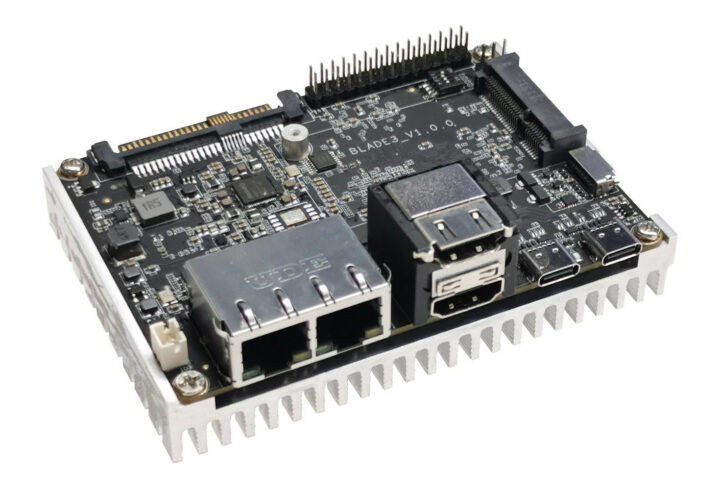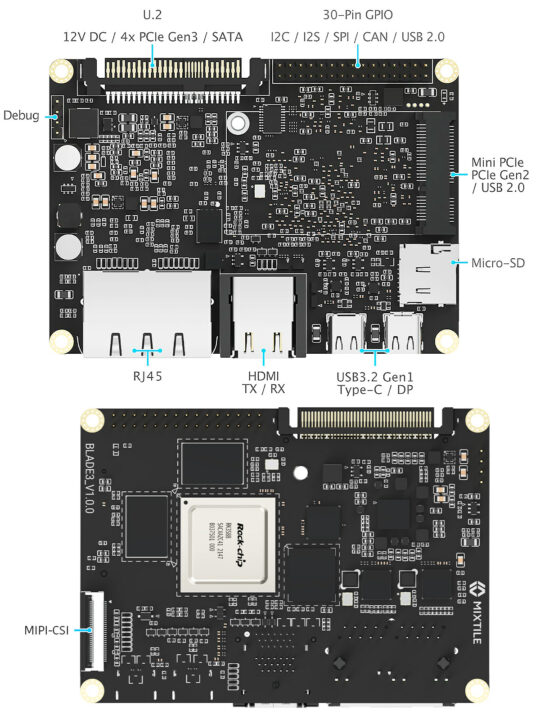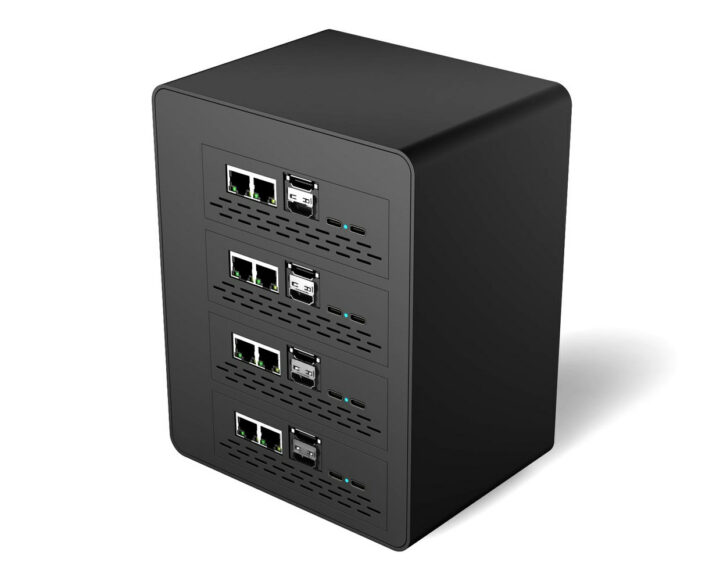The Mixtile Blade 3 Pico-ITX single board computer (SBC) powered by Rockchip RK3588 processor has now launched on Crowd Supply with either 8GB or 16GB RAM, and an optional four-node cluster box with a built-in PCIe switch designed to accommodate four Mixtile Blade 3 boards.
The board also comes with up to 128GB of storage, two 2.5GbE interfaces, HDMI 2.1 output, HDMI 2.0 input, USB 3.2 Gen 1 USB Type-C ports, as well as a mini PCIe Gen 2 for expansion and a 30-pin GPIO header for expansion, as well as U.2 edge connector with 12V, PCIe x4 Gen 3 and SATA signals to interface with other Mixtile boards and build clusters.
Mixtile Blade 3 specifications:
- SoC – Rockchip RK3588 octa-core processor with four Arm Cortex-A76 cores @ up to 2.4 GHz, four Arm Cortex-A55 cores, Arm Mali-G610 MP4 quad-core GPU with support for OpenGL ES3.2, OpenCL 2.2, Vulkan1.1, 6 TOPS NPU, 48MP ISP, 8Kp60 video decoding, 8Kp30 H.264/H.265 video encoding
- Memory & storage configurations
- 4GB LPDDR4 and 32GB eMMC flash
- 16GB LPDDR4 and 128GB eMMC flash
- Common – MicroSD 3.0 card socket; SATA 3.0 and PCIe (NVMe) via U.2 edge connector,
- Video interfaces
- HDMI 2.1 output up to 8Kp60 or 4Kp120
- 4-lane MIPI DSI
- DisplayPort 1.4a via USB-C ports
- HDMI 2.0 input up to 4Kp60
- MIPI CSI camera interface
- Networking – Dual 2.5 Gigabit Ethernet RJ45 ports with link aggregation
- USB – 2x USB 3.2 Gen1 Type-C ports with DisplayPort 1.4a Alt. mode
- Expansion
- U.2 edge connector with 4-lane PCIe Gen3, SATA 3.0, 12V
- Mini PCIe socket with PCIe Gen 2.1 and USB 2.0
- 30-pin GPIO header with GPIOs, I2C, USB 2.0, TTL UART, SPI, I2S, CAN
- Power Supply – 12V DC via U.2 connector (“standard SATA power in”)
- Dimensions – 100 x 72 mm (2.5-inch Pico-ITX form factor)
- Temperature Range – 0 to +80°C
As discussed in the initial announcement, Mixtile does not directly offer Linux support, but instead, runs a Linux container within the Android 12 image preloaded on the board. What’s new is the board will ship with a large heatsink in a design similar ODROID-N2+ board for instance. The documentation does not seem to be up yet, but the support forum is.
The company says it’s possible to create a cluster of 75 Mixtile Blade 3s in a 19-inch 2U chassis with up to 600 processor cores while drawing less than 1500 W of power. For smaller deployments and evaluation, there’s also a four-node cluster box to create a neat system instead of going the usual acrylic case and spacers setup.
Typical applications for the Mixtile Blade 3 include on-premise high-performance servers, low-power HPC cluster nodes, advanced HMI systems with extensive image processing capabilities, compact computing clusters, high-density server integrations for MLOps deployments, big-data storage and processing for 3D graphics and AI applications, edge computing for autonomous vehicles, real-time video streaming and more.
The Rockchip RK3588 Pico-ITX board is available on Crowd Supply for $169 with 4GB RAM and 32G eMMC flash, and $259 in 16GB/128GB configuration. The 32GB RAM model is not offered yet, and I don’t think any company is currently selling RK3588 hardware with 32GB RAM despite the various announcements to the contrary. A $239 pledge is asked for the four-node cluster box. We don’t have many details about it, except “the batteries are not included”. So I’d assume there may be a UPS function too? Shipping adds $10 to the US, and $20 to the rest of the world, with deliveries scheduled to start by the end of October 2022.

Jean-Luc started CNX Software in 2010 as a part-time endeavor, before quitting his job as a software engineering manager, and starting to write daily news, and reviews full time later in 2011.
Support CNX Software! Donate via cryptocurrencies, become a Patron on Patreon, or purchase goods on Amazon or Aliexpress







